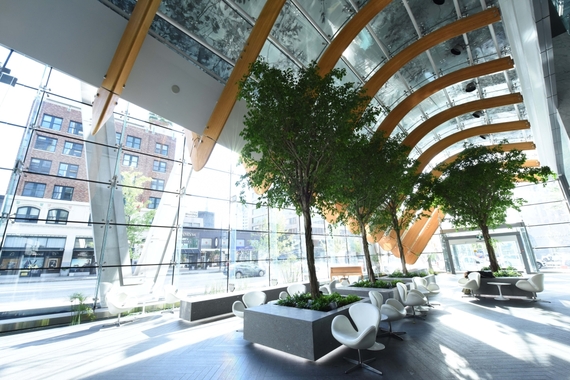
We have all entered an office building at one time or another and remarked, "This is a hellhole."
You may be aware of the type of structure I am referring to. Their features could have included the following:
- Cubicles built by the makers of tanks and nuclear bunkers;
- Hallways adorned with orange, flea-infested industrial carpet;
- Paintings of Queens and posters of uninspiring figureheads hung from the walls;
- Bathrooms mocking themselves as actually usable;
- Staffrooms and cafeterias possessing three chairs for a team of fifteen;
- Windowless meeting rooms with a phone, but not one that had a hands-free speaker option.
When an employee spends 40 hours a week in a building that is not only lacklustre, it is damaging employee commitment and morale, then perhaps it is time to rethink your organizational culture strategy.
I have been to many office buildings throughout my career. Whether in North America, Europe or Australia, I have witnessed the good and the not-so-good of corporate headquarters. I once sat in the foyer of a company waiting for my meeting to start. Out of the corner of my eye I saw two employees standing on a table in a meeting room trying to connect their laptop to the LCD projector that was hanging overhead. It demonstrated teamwork, but I thought it might be a wee bit of a safety hazard, too.
Another time, when I was being led from the front desk to a meeting room, my escort apologized for the lighting. "Sorry it is so bright in here," she said. "We can't seem to figure out how to dim any of these lights." If by bright she meant like the 7,000-watt xenon lamps fixed atop the Luxor hotel pyramid on the Las Vegas Strip, then yes, I would have agreed with her.
But when an organization does indeed create an office environment and atmosphere that emits harmony, collaboration and a sense of vitality throughout its confines, there is an undeniable and infectious culture that manifests.
Take for instance Google, and its famous Googleplex.
Located at 1600 Amphitheatre Parkway in Mountain View, California, Googleplex is the corporate headquarters of Google. Its sprawling 3 million square feet campus houses the majority of its global workforce (roughly 19,000 people according to the San Francisco Chronicle) and was also the scene for the comedy movie, The Internship starring Vince Vaughn and Owen Wilson.
But what is it that makes Googleplex so unique? Why is it written about so often?
When I visited, sure, you notice perquisites pretty much everywhere. There are car washes, dry cleaning drop-off areas, pop-up hair salons, fitness centers, mobile libraries ... and food in just about every other corner. The kitchens are spectacular offering breakfast, lunch and dinner across an array of menu items that could compare with some Michelin restaurants. But Googleplex is more than simply perquisites like the use of bikes to ride across the campus. There is a vibe at Googleplex, a sense of community.
In his book, Work Rules: Insights From Inside Google That Will Transform How You Live And Lead, Laszlo Bock (Google's head of People Operations) writes, "A sense of community helps people do their best work just as surely as increasing efficiency does by sweeping away minor chores and distractions." Buildings can create this sense of community. If they are built right, if the buildings permit collaboration and openness, good things can result from both the organization's culture and its results.
Bock continues, "All of these programs work to create efficiency, community, or innovation. Some might argue that this is a gilded cage, a trick designed to convince Googlers to work more or stick around longer. But that fundamentally misunderstands not just our motives, but also how work happens in companies like ours."'
My place of work, TELUS, is another example. It has been refurbishing its buildings and erecting brand new structures for several years now.
TELUS Garden is one of those. Just opened this fall, the building is a $750-million, one-million-square-foot development made up of a 24-floor office tower--and new corporate headquarters for TELUS--pitted alongside a 53-floor residential tower that will open in the spring. Interestingly, almost half of all commercial condominium units in the residential tower were purchased by TELUS team members. The new headquarters is located in the heart of downtown Vancouver. Not only is it creating a renewed sense of collaboration and spirited teamwork for the 1000 team members that permanently work out of this building (and hundreds more dropping in as needed) the office tower is submitting for the new more stringent Leadership in Energy and Environmental Design (LEED) Platinum Certification, a first in Canada.
One of the standout sustainable features of the development is the innovative district energy system nested inside the building. This system will permit CO2 emissions reductions by over a million kg per year. By recapturing heat from TELUS data centres housed onsite, it allows the new headquarters to reduce its conventional energy demand for heating and cooling by over 80 percent. The development partner of TELUS Garden, Westbank, says, "Of all the building features that contribute to the LEED Platinum certification, the district energy system alone makes the building the most energy efficient piece of real estate in Vancouver."'
Then there is an Innovation Centre, where the company and its team members try out raw ideas and incubate new concepts that will eventually benefit the customer base. Cantilevered spaces hanging over major road arteries maximizes the vertical space and square footage of the building itself. The building boasts more than 10,000 square feet of garden space - that doubles as outdoor workspace - across six different levels with over 1,000 species of plants and trees. Next season, team members will grow and harvest produce onsite. The top floor houses Vancouver's largest array of solar panels (nearly 300 in total) that power the external lighting of the building, not to mention the installation of a rainwater capture system that is used to irrigate all of the various gardens found throughout the building.
Of course as you would expect in a brand new headquarters, there are collaborative and private meeting rooms, open seating areas, shared work stations, outdoor terraces, kitchens and all sorts of amenities. The building features unique design elements, such as a raised floor system, 100 percent fresh air ventilation, radiant heating and cooling, higher than average ceiling heights and operable windows. Imagine that. An office tower where you can open the windows.
What does all of this mean?
Whether at Google or at TELUS, a building can have a wonderful and positive effect on the culture of your organization. In this shift toward flexible work--where employees are often mobile or even working from home 90 percent of the time--going into "the office" should feel welcoming, warm and inviting. If your buildings are closed, dilapidated or relics from the 1970s, it may be having detrimental effects on your culture. It may be causing disengagement, reduced productivity and even a lack of innovation. It cannot feel great for those 'stuck' working in the building 100 percent of the time. And for those who are mobile or working from home, why would they want to come into the building if it's not inviting?
For those that work full-time or part-time in the building, having access to amenities and collaborative space while being afforded the luxury of working in a sustainable building may actually increase employee engagement. A 2012 report by Engage for Success, for example, suggested the physical work environment and the buildings where employees work create the basis in which 'employee commitment' begins. It suggested that any positive changes to the physical environment of an employee's workspace increases physical comfort and wellness, thus creating an environment that is conducive to increasing employee engagement.
Indeed, a study conducted by University of Notre Dame management professors Edward Conlon and Ante Glavas investigated the relationship between corporate sustainability and financial performance by virtue of analyzing 562 US banking branches (93 were LEED certified and 469 were non-LEED). The researchers found those working in LEED-certified buildings were "more productive and engaged in their work."
Can a building improve employee engagement?
It almost sounds like a moot question. The flipside is whether a stodgy building replete with fluorescent lighting, rickety chairs and windowless meeting rooms--possessing a lack of perquisites and amenities--is how employees want to be treated in today's age of employment choice.
It is not a question about employee engagement.
It is about whether or not your building is mimicking your corporate culture.
__________
Dan Pontefract is the author of FLAT ARMY: Creating a Connected and Engaged Organization and is Chief Envisioner at TELUS Transformation Office. His next book, THE PURPOSE EFFECT: Building Meaning in Yourself, Your Role and Your Organization, will publish May 10, 2016.

